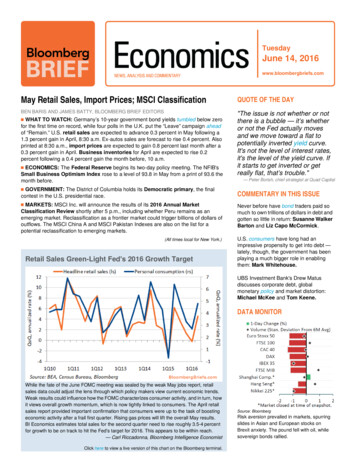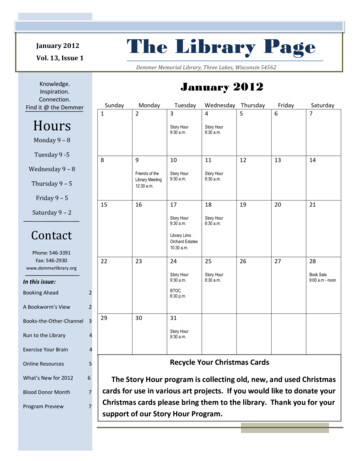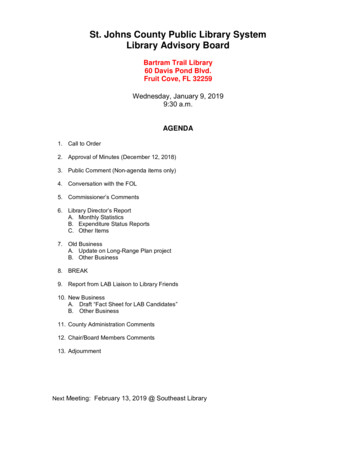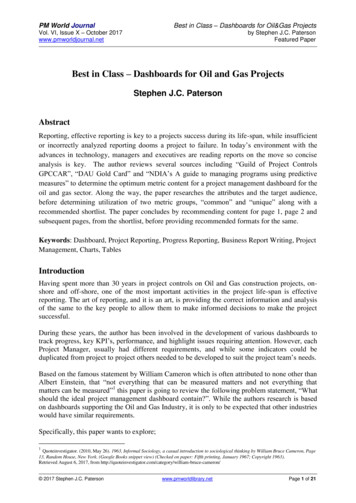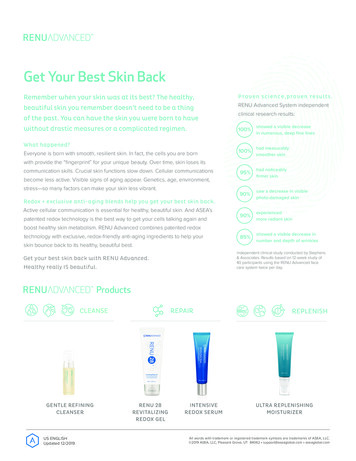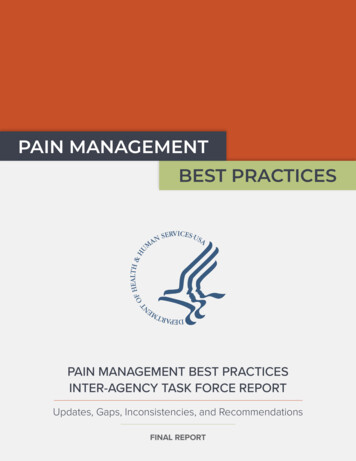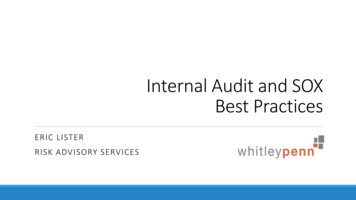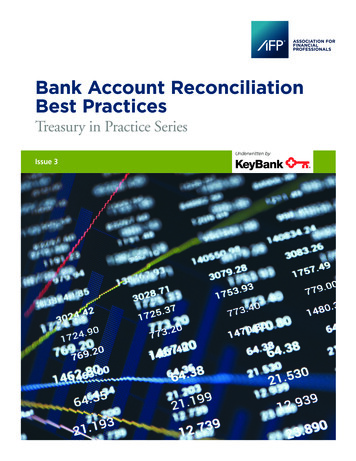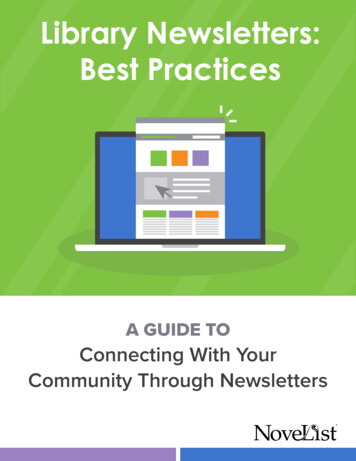
Transcription
Library Newsletters:Best PracticesA GUIDE TOConnecting With YourCommunity Through Newsletters
IntroductionNewsletters are an effective way to make a meaningfulconnection with your library community. Even better—it’s easy and convenient for them, as well as for you.123Anatomy of a Good e-Newsletter1Subject line – maximum 50 characters2Make it eye catching: Use a big image at the top to grabeyeballs! (And make sure the image is on brand andrelevant.)3Keep the text short to allow your subscribers to skim & scan4CTA: Have a clear and concise call to action. What is it thatyou want your readers to do?5Signature/footer — this is a great place to have yourlibrary’s branding45For more than a decade, NoveList has provided NextReads, an award-winning newsletter servicefor libraries; our LibraryAware newsletters are popular ways to keep patrons up to date on libraryprograms and services.These tips come from libraries big and small, urban and rural, in the United States, Canada, Australia,and New Zealand. We’re sharing them in the hope that they will help you engage seniors, parents ofyoung children, readers, job hunters — whomever you’re trying to reach.NoveList Library Newsletters: Best Practices 20192
Planning for Your NewsletterKeep these five steps inmind as you plan yournewsletter:1Determine Your Goals2Gather Intelligence3Set up for Success4Establish Your Brand5Analyze Your Results1. Determine Your GoalsWhat are your goals? What will make this aneffective and successful newsletter? It’s hard toknow if your newsletter is working for your libraryif you’ve not yet determined what success lookslike.The first place to look for goals for yournewsletter is your library’s strategic plan. Yourstrategic plan probably has goals such as“support literacy in our community;” “encouragereading;” “increase attendance at programming;”“reach more adults without children,” etc.A newsletter can support all of these goals.Don’t have a strategic plan or currently in theprocess of creating a new one? You can developgoals for whatever you want to accomplish —including increasing circulation, higherattendance at book clubs, increasingcardholders, updating your community aboutnew building projects, etc. — and consider how aregular newsletter will help support these goals.Subject Line Best Practices:Short, sweet, andto the point:Email subject linesshould communicatethe content of theemail. A tall order?Yes! But it should beclear what this emailis before your patronsopen it.A few successful subject lines: Celebrate Women’s History & Teen Tech! Books in the National Media: March 11 - 17, 2019 New Arrivals: March 2019 Back to School: 4 Online Resources for HomeworkHelp Monthly Newsletter: Artsy Affairs to Zombie ScaresNumbers get results:Numbers in subject lines draw attention more than adescriptions do.Questions do the trick, too:Leading with a question that makes your readers thinkor stirs emotions will help open emails.Avoid words that trigger spam filters:Words like “free” or even “money” could potentiallysend your email to spam. Familiarize yourself withwords and phrases that are likely to cause these triggers.NoveList Library Newsletters: Best Practices 20193
2. Set up for Success How much time can you commit to yournewsletter? Before beginning your newsletter isa good time to ask yourself practical questionsabout the time you can dedicate to thisnewsletter. How often will you need to send outyour newsletter? Are you creating a weeklyprogramming newsletter? A monthly readingrecommendations newsletter? Or perhaps aquarterly update on how various building projectsare going?Where will the content come from? Knowinghow often you plan to distribute and whether itwill be an individual or group effort will help youevaluate how easy it will be to create content foryour newsletter. If, for example, your library hasthe resources to offer storytimes every week, butnot other children’s programs, perhaps a monthlyprogramming newsletter is a better option than aweekly one. If the building project is goinggangbusters your community will want to seeinspiring images and updates every month ratherthan quarterly. Is your newsletter accessible? Reachingsubscribers includes creating emails that areaccessible to everyone. This means consideringbest practices such as text size and color, usingproper alt text for images, and meaningful linktext. Include a plain-text version for subscriberswho prefer this format.Are you compliant? Sending email requiresknowledge and understanding of local andapplicable email marketing laws: CAN-SPAM inthe U.S., CASL in Canada, GDPR in Europe,ACMA in Australia, and EUMA in New Zealand.Familiarize yourself with these laws and staycompliant.Three Steps to a Better CTA:A “call-to-action” or CTA is a prompt in your email that asks your subscribers to take a nextstep. It is indicated by a line of text or image that instructs the next action to take and isoften hyperlinked. “Learn more” is an example of a common CTA.Review these three steps as you think about the actionsyou might want your subscribers to take when readingyour newsletter:1. Consider the placement: Is the CTA in a prominent spot in the email?Is there an image or graphic to draw attention?2. Use exciting language: “Click here” may be the most commonexample that we all recognize, but it’s no longer very exciting oreffective. Change up the language when you can. If you’re promotingan event, instead of “Register here” try something like “Sign me up!”3. Use the right colors: What will stand out and draw attention but alsolook visually pleasing within your email and alongside your library’sbranding? Consider accessibility; backgrounds and text with highcontrast are more easily seen by those with impaired vision.NoveList Library Newsletters: Best Practices 20194
3. Gather IntelligenceIf you’re already doing a newsletter, identify what is and isn’t working.Ask your staff what they like about the newsletter. Consider a brief subscribersurvey. Check open and click rates. Track what kind of links people areclicking. Evaluate if the tone of your newsletter matches the images youinclude and the audience you’re trying to reach.Identify the audience(s) you WANT toreach. If this is your first newsletter, youmight want to start small. An excellentplace to start is with an audience yourlibrary already has success reaching —think parents of young kids (storytimes,picture book collections, craft programs,etc.). Another way to determine yourtarget audience is to go back to yourgoals and your strategic plan. Does your strategic plan include careerguidance? Then job seekers would be an excellent target audienceto identify. Do you have a growing number of entrepreneurs in yourcommunity? How will you reach them?Determine your audience segments.Asking yourself lots of questions about the people who make up your targetaudience will help you hone in on how to appeal to their needs. What are theirinterests? When are they likely to come to the library? What library resourcesdo they like to use? You can get ideas from the private sector as well bylooking at the brands and companies that might interest your audience. Forexample, if you’re targeting a youngeraudience interested in subscriptionservices, take a look at ads and emailsfor subscription services and incorporatesimilar designs, features, and language.““Newsletters are effective because they're able toreach patrons more directly than any other marketing.These days, most people keep their email in theirpocket, so newsletters find them wherever they are.With the 20-30 somethings especially, the #LibSocialand general library email newsletters account for acombined 24% of all program attendee referrals.”JEZ LAYMAN, ADULT SERVICES LIBRARIAN,INDIAN PRARIE PUBLIC LIBRARY“NoveList Library Newsletters: Best Practices 20195
4. Establish Your BrandYour target audience and your goals will be the basis for helping you understand the tone of youremail and the designs you include.Branding: Consistency is key. When your community receives a communication from you, it should berecognizable and consistent. Is your logo included in the header or footer? Does the footer have key contactinformation? Is the color palette of your communication consistent with your website and branding guidelines?Style: Is your audience looking for serious information or something a bit lighter? Parents of young childrenlooking for programming and picture books will probably enjoy bright colors and illustrations, while job seekerswill be looking for a design that includes more business-like images and text.Tone: Will your audience connect with the tone? Emojis and memes can lighten up a newsletter, but yourseniors may not appreciate the jokes. Similarly, references to “Use it up, wear it out, make it do, or do without”may be lost on a younger generation.One thing to keep in mind is to KEEP IT PERSONAL. It’s a letter from you toa member of your community. Above all, don’t forget where this whole thingstarted: Connecting with your community.NoveList Library Newsletters: Best Practices 20196
5. Analyze Your ResultsThe average open rate for nonprofits and educational sectors is roughly 21-26%. If your open rates are in thatrange, you are doing well. If they are higher than that, you’re doing awesome!UnsubscribeRateBounceRateIndustryOpen RateEducation & Training21.17%2.71%.2.54Entertainment and onprofit25.13%2.84%.19.47CTRLinchpinSEO: -industry/Don’t get *too* stuck on the numbers.Though these might be helpful benchmarks and will perhaps help you pinpoint a long-term goal for metrics,don’t get too hung up on the numbers. For now, focus on trends over time. Are you building your subscriber list?Is your unsubscribe rate low? Are you seeing increased attendance at programs promoted in your newsletter?Think back to the goals you determined for yourself at step one. Are you meeting or even exceeding thosegoals?Glossary of Email MetricsOpen RatePercentage of recipients that opened the email. This shows awareness of your emailand interest in what you have to share.Click Through Rateor CTRPercentage of recipients that clicked on any link in your email. This shows engagementbecause an action was taken to learn more.Unsubscribe RatePercentage of recipients who unsubscribed from the email message. This tells you whois not interested in your message. A few unsubscribes is normal; watch for trends overtime. If this figure increases dramatically, it’s time to assess whether your message isright for your audience.Bounce RatePercentage of email addresses in subscriber lists that were returned by the recipientmail server. If this number is high, check to see if the majority of email domains are thesame. That could indicate an issue with that provider. Or, you might need to scrub yourlist of incorrect or old emails.A/B TestingA method of comparing two versions of something (i.e., an email) against each other todetermine which one performs better. Only one variable, such as a subject line, shouldbe tested at a time.NoveList Library Newsletters: Best Practices 20197
5. Analyze Your Results (cont.)If you’ve been at this for some time and are stillseeing low numbers, perhaps it’s time to analyzewhat is working and what is not. Some questions toask yourself as you’re reviewing your content,design, and voice: Is your newsletter interesting? Be honest withyourself — how’s the writing? Could you make itbetter? Are your images eye-catching andrelevant? Are your readers engaging with theemails? What kinds of links get the highest clickrates, and which get the lowest? For example,you may find that you get high click rates onlinks to books in your collection versus links todatabases? Knowing what links are clicked mostoften can help you make editorial decisions overtime. Is your email providing valuable informationsubscribers can’t easily find anywhere else?Is the information you’re providing solving aproblem? Or are you telling them the same thingevery week? Is your newsletter concise? It’s tempting toinclude all your information in the newsletterrather than keeping text brief and linking toplaces with further details such as blog posts,your website, and programming calendars, but allthat makes newsletters longFAST. Keep your newslettersshort and sweet and let yourreaders click to learn more ifthey want.Connecting with yourcommunity today meansbringing the information to them,wherever they are — at home, ina waiting room, at the ballpark —anywhere their mobile device willtake them. Newsletters can serveas an essential outreach effort innew and effective ways.““Newsletters are an easy and effectiveway for us to reach key audiences, likeour Square One Small Business Servicesnewsletter. We can target our messageto a specific mailing list to promote thebusiness resources, programs, andone-on-one service local entrepreneursneed — and might not know that ourlibrary provides.”TOMMY HARDIN,ONLINE MARKETING COORDINATOR,MID-CONTINENT PUBLIC LIBRARYWant to see morenewsletters we love?Go to http://bit.ly/NewslettersWeLoveNoveList Library Newsletters: Best Practices 20198
Eight Proven Ideas for Growing Your Subscriber List:1Make sure staff knowsabout the newsletterand get them signed up!They’re patrons, too, andshould be interested inwhat’s happening at theirlibrary.2Ask people to subscribe when they get their library card“ we’ve added a checkbox on our library card application.That way customers can indicate they want to receive libraryemails. For our welcome email, we sent 24,280 emails; 78people opted out. We got zero complaints and a handful ofcompliments.”RHONDA MASSIE, BLOOMINGTON PUBLIC LIBRARY43Sign up people at events5Add an opt-in link to your library’s website6Set up a table near the checkout wherepeople can sign up on the spot7Create a poster or sign letting pa
Anatomy of a Good e-Newsletter Subject line – maximum 50 characters Make it eye catching: Use a big image at the top to grab eyeballs! (And make sure the image is on brand and relevant.) 3 Keep the text short to allow your subscribers to skim & scan CTA: Have a clear and concise call to action. What is it that you want your readers to do? Signature/footer — this is a great place to have .

